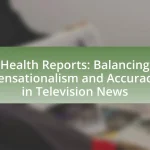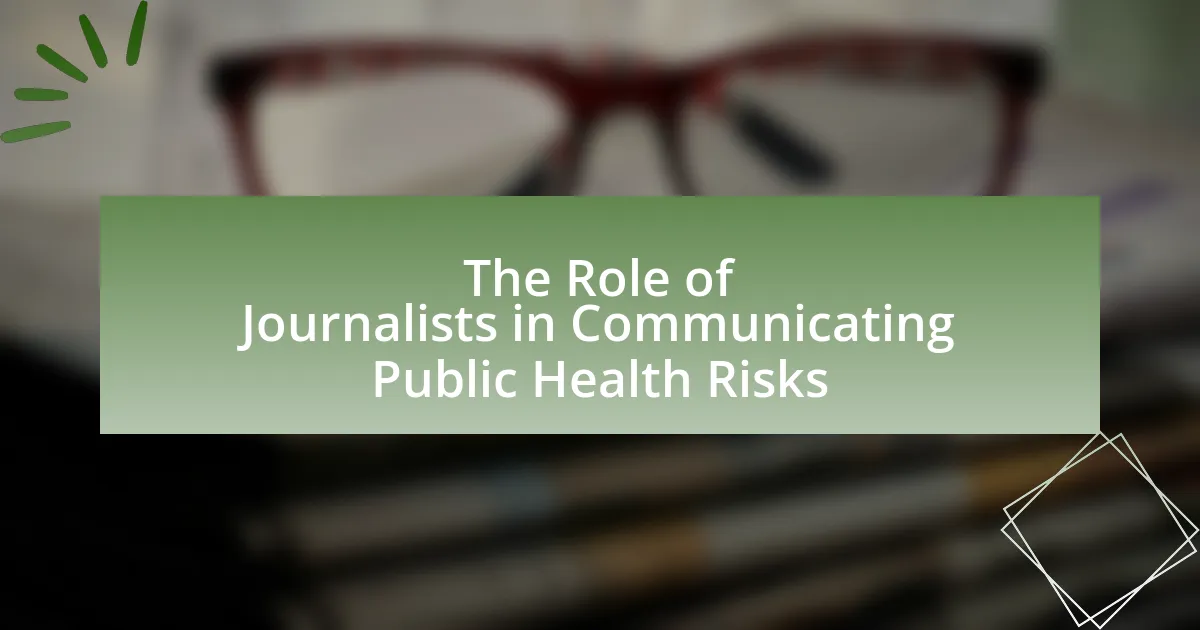The article examines the evolution of health reporting in television news, highlighting its transition from simplistic coverage to a more nuanced and comprehensive approach over the decades. Key milestones include the introduction of health segments in the 1950s, the rise of investigative journalism in the 1980s, and the impact of digital platforms in the 2000s. The article also discusses the influence of public health crises, such as the COVID-19 pandemic, on health reporting, as well as the challenges posed by misinformation and sensationalism. Additionally, it emphasizes the importance of accuracy, expert collaboration, and ethical considerations in enhancing the quality of health news coverage.

What is the Evolution of Health Reporting in Television News?
The evolution of health reporting in television news has transitioned from simplistic coverage of health issues to a more nuanced and comprehensive approach. Initially, health reporting focused primarily on major medical breakthroughs and public health crises, often lacking depth and context. Over the decades, particularly from the 1980s onward, there has been a significant shift towards incorporating expert opinions, patient stories, and a focus on preventative health measures. This change has been driven by advancements in medical research, increased public interest in health topics, and the rise of health-related programming. For instance, the introduction of health segments in daily news broadcasts and the emergence of dedicated health shows have contributed to a more informed public. Furthermore, the integration of digital platforms has allowed for real-time updates and interactive health content, enhancing viewer engagement and understanding.
How has health reporting changed over the decades?
Health reporting has evolved significantly over the decades, transitioning from simplistic coverage to a more nuanced and evidence-based approach. In the 1960s and 1970s, health news primarily focused on major medical breakthroughs and public health crises, often lacking depth and context. By the 1980s and 1990s, the rise of investigative journalism led to more critical examinations of health policies and practices, highlighting issues such as healthcare access and pharmaceutical ethics.
In the 2000s, the advent of the internet and social media transformed health reporting, allowing for real-time updates and broader public engagement. Journalists began to incorporate scientific research and expert opinions more rigorously, improving the accuracy and reliability of health information. Recent trends emphasize personalized medicine and mental health, reflecting societal shifts in understanding health and wellness.
This evolution is supported by studies indicating that audiences now demand more comprehensive and scientifically accurate health reporting, as evidenced by the increased viewership of health-related segments that provide in-depth analysis rather than superficial coverage.
What were the key milestones in health reporting on television?
Key milestones in health reporting on television include the introduction of televised health segments in the 1950s, the establishment of dedicated health news programs in the 1980s, and the rise of health documentaries in the 1990s. In the 1950s, programs like “The Doctor” began to educate the public on health issues, marking the start of health reporting on television. The 1980s saw networks like CNN and NBC launch specific health segments, increasing the visibility of health topics in mainstream news. By the 1990s, health documentaries, such as PBS’s “Frontline,” provided in-depth explorations of critical health issues, further enhancing public awareness and understanding of health matters. These milestones reflect the evolving role of television in disseminating health information to the public.
How did technological advancements influence health reporting?
Technological advancements significantly influenced health reporting by enhancing the speed, accuracy, and accessibility of health information. The introduction of digital platforms and real-time data analytics allowed news organizations to disseminate health updates rapidly, particularly during public health crises like the COVID-19 pandemic. For instance, the use of social media and mobile applications enabled immediate sharing of health alerts and guidelines, reaching a broader audience than traditional methods. Furthermore, advancements in data visualization tools improved the clarity of complex health statistics, making them more understandable for the general public. This shift not only increased public awareness but also fostered a more informed citizenry regarding health issues.
Why is health reporting significant in television news?
Health reporting is significant in television news because it informs the public about critical health issues, enabling informed decision-making. This type of reporting raises awareness about diseases, health policies, and preventive measures, which can directly impact community health outcomes. For instance, during the COVID-19 pandemic, television news played a crucial role in disseminating information about safety protocols, vaccination efforts, and public health guidelines, ultimately influencing public behavior and compliance. Studies have shown that effective health communication can lead to increased health literacy, which is essential for managing personal and community health effectively.
What role does health reporting play in public awareness?
Health reporting plays a crucial role in enhancing public awareness about health issues and promoting informed decision-making. By disseminating accurate information on diseases, treatments, and health policies, health reporting empowers individuals to understand their health better and encourages proactive health behaviors. For instance, studies have shown that increased health reporting during public health crises, such as the COVID-19 pandemic, significantly influenced public knowledge and compliance with health guidelines, leading to better health outcomes. This demonstrates that effective health reporting not only informs the public but also shapes health-related behaviors and attitudes.
How does health reporting impact viewer behavior and health decisions?
Health reporting significantly influences viewer behavior and health decisions by shaping perceptions and knowledge about health issues. Research indicates that exposure to health news can lead to increased awareness of health risks and motivate individuals to adopt healthier behaviors, such as exercising or seeking medical advice. For instance, a study published in the Journal of Health Communication found that viewers who regularly consume health-related news are more likely to engage in preventive health measures, such as vaccinations and screenings. This correlation demonstrates that effective health reporting not only informs the public but also drives actionable health choices, ultimately impacting community health outcomes.

What are the major trends in health reporting on television?
Major trends in health reporting on television include an increased focus on mental health, the integration of technology in health communication, and a rise in personalized health narratives. Mental health reporting has gained prominence, reflecting societal shifts towards recognizing mental well-being as equally important as physical health, evidenced by a 2021 survey indicating that 76% of Americans believe mental health is a critical aspect of overall health. The use of technology, such as telemedicine and health apps, has transformed how health information is disseminated, with a 2020 report showing that telehealth visits increased by 154% during the COVID-19 pandemic. Additionally, personalized health stories have become more prevalent, allowing viewers to connect with health issues on a personal level, as seen in various segments that feature individual patient experiences and outcomes.
How have health topics covered in television news evolved?
Health topics covered in television news have evolved from primarily focusing on acute medical issues to encompassing a broader range of public health concerns, including chronic diseases, mental health, and preventive care. In the 1960s and 1970s, television news predominantly reported on immediate health crises, such as epidemics and medical breakthroughs. Over the decades, there has been a significant shift towards addressing lifestyle-related health issues, such as obesity and diabetes, reflecting changing societal health challenges. For instance, the rise of the obesity epidemic in the 1990s prompted extensive coverage on nutrition and exercise. Additionally, the integration of mental health discussions into mainstream news has increased, particularly following the COVID-19 pandemic, which highlighted the importance of mental well-being. This evolution is supported by studies indicating that health reporting now emphasizes holistic approaches to health, aligning with public interest in comprehensive health education and awareness.
What health issues have gained prominence in recent years?
Mental health issues, particularly anxiety and depression, have gained prominence in recent years. The World Health Organization reported a 25% increase in anxiety and depression globally during the first year of the COVID-19 pandemic, highlighting the growing recognition of mental health as a critical public health concern. Additionally, chronic diseases such as diabetes and obesity have also seen increased attention, with the Centers for Disease Control and Prevention indicating that obesity rates have tripled since the 1970s, emphasizing the need for public awareness and intervention.
How has the portrayal of health professionals changed in the media?
The portrayal of health professionals in the media has shifted from a predominantly heroic and infallible image to a more nuanced representation that includes their vulnerabilities and ethical dilemmas. Historically, health professionals were depicted as unwavering figures of authority, often idealized in television dramas and news segments, which reinforced a trust in their expertise. However, recent portrayals have begun to reflect the complexities of their roles, showcasing challenges such as burnout, moral conflicts, and the impact of systemic issues on healthcare delivery. This change is evidenced by series like “The Good Doctor” and “Grey’s Anatomy,” which not only highlight medical triumphs but also delve into personal struggles and ethical questions faced by healthcare workers, thus providing a more realistic and relatable view of their profession.
What influence do public health crises have on health reporting?
Public health crises significantly influence health reporting by increasing the urgency and frequency of coverage, as seen during events like the COVID-19 pandemic. During such crises, news outlets prioritize health-related stories, often leading to a surge in public interest and demand for accurate information. For instance, a study by the Pew Research Center found that 73% of Americans reported following news about the coronavirus outbreak closely, which prompted media organizations to allocate more resources to health reporting. This shift not only enhances the visibility of health issues but also shapes public perception and understanding of health risks, ultimately affecting health behaviors and policy responses.
How did the COVID-19 pandemic reshape health news coverage?
The COVID-19 pandemic significantly reshaped health news coverage by increasing the demand for real-time information and emphasizing the importance of accurate reporting. News outlets adapted by prioritizing health-related stories, often featuring expert opinions and scientific data to inform the public about the evolving situation. According to a study by the Pew Research Center, 71% of Americans reported following news about the pandemic closely, which led to a surge in viewership for health segments on television. This shift resulted in a more prominent role for public health officials in media narratives, highlighting the necessity for transparency and trust in health communications during a crisis.
What lessons were learned from past health crises in reporting?
Past health crises have taught the importance of timely and accurate reporting to prevent misinformation and panic. For instance, during the 2003 SARS outbreak, media coverage highlighted the need for clear communication from health authorities to ensure the public received reliable information, which helped mitigate fear and confusion. Additionally, the Ebola outbreak in 2014 underscored the necessity of contextualizing data, as sensationalized reporting led to stigma against affected communities. These lessons emphasize that responsible journalism can significantly influence public perception and response during health emergencies.

What are the challenges faced in health reporting on television?
Health reporting on television faces several challenges, including the complexity of medical information, the need for accuracy, and the pressure of time constraints. The complexity arises from the necessity to simplify intricate health topics for a general audience while maintaining factual integrity. Accuracy is critical, as misinformation can lead to public health risks; for instance, a study published in the Journal of Health Communication found that inaccurate health reporting can significantly influence public perceptions and behaviors. Time constraints often limit the depth of coverage, forcing reporters to condense information, which can lead to oversimplification or omission of essential details. These challenges collectively hinder the effectiveness of health communication on television.
How do misinformation and sensationalism affect health reporting?
Misinformation and sensationalism significantly distort health reporting by promoting inaccurate narratives and exaggerating risks. This distortion can lead to public confusion, fear, and mistrust in health information sources. For instance, a study published in the journal “Health Affairs” found that sensationalized health news can lead to increased anxiety among the public, as seen during the Ebola outbreak when exaggerated reports heightened fears despite low transmission risk in the U.S. Furthermore, misinformation can result in harmful health behaviors, such as vaccine hesitancy, which has been linked to the spread of false information about vaccine safety. Thus, the impact of misinformation and sensationalism on health reporting is profound, undermining public health efforts and informed decision-making.
What strategies can be employed to combat misinformation in health news?
To combat misinformation in health news, employing fact-checking initiatives is essential. Fact-checking organizations, such as PolitiFact and Snopes, verify claims made in health reporting, providing accurate information to the public. Additionally, promoting media literacy among consumers helps individuals critically evaluate health news sources, reducing the spread of false information. Research indicates that media literacy programs can significantly improve the ability of individuals to discern credible information from misinformation. Furthermore, collaboration between health professionals and journalists can ensure that accurate, evidence-based information is disseminated, as seen in initiatives like the Health News Review, which evaluates the quality of health news reporting.
How does sensationalism impact public perception of health issues?
Sensationalism significantly distorts public perception of health issues by exaggerating risks and creating fear. This distortion often leads to heightened anxiety among the public, as seen in the coverage of health crises like the Ebola outbreak, where media reports emphasized worst-case scenarios, resulting in widespread panic despite low transmission rates in many regions. Research published in the Journal of Health Communication indicates that sensationalized reporting can lead to misinformed public beliefs about health risks, ultimately affecting health behaviors and policy responses.
What ethical considerations are involved in health reporting?
Ethical considerations in health reporting include accuracy, transparency, and the potential for harm. Journalists must ensure that health information is factually correct and based on credible sources to avoid misinformation, which can lead to public health risks. Transparency involves disclosing conflicts of interest and the sources of information, allowing audiences to assess the reliability of the content. Additionally, reporters must consider the potential emotional and psychological impact of health stories on individuals and communities, particularly when discussing sensitive topics such as illness or death. These ethical principles are essential to maintain public trust and promote informed decision-making regarding health issues.
How should journalists balance accuracy and urgency in health news?
Journalists should prioritize accuracy over urgency in health news by verifying information through credible sources before reporting. This approach is essential because inaccurate health information can lead to public panic or misinformation, as evidenced by the rapid spread of false claims during health crises like the COVID-19 pandemic. Research from the Pew Research Center indicates that 64% of Americans believe that news organizations should prioritize accuracy over speed. Therefore, journalists must implement rigorous fact-checking processes and collaborate with health experts to ensure that the information disseminated is both timely and reliable.
What are the implications of privacy concerns in health reporting?
Privacy concerns in health reporting can lead to reduced public trust in media sources and hinder the dissemination of critical health information. When individuals fear that their personal health data may be exposed or misused, they may be less likely to participate in health studies or share their health experiences, which can limit the depth and accuracy of health reporting. For instance, a study published in the Journal of Medical Internet Research found that 60% of respondents expressed concerns about privacy when sharing health information online, indicating a significant barrier to effective health communication. This lack of trust can ultimately affect public health outcomes, as accurate reporting is essential for informed decision-making and community health initiatives.
What best practices can enhance health reporting in television news?
Best practices that can enhance health reporting in television news include ensuring accuracy, providing context, and utilizing expert sources. Accuracy is crucial; reports should be fact-checked and based on reliable data to prevent misinformation, as seen in studies showing that inaccurate health information can lead to public health risks. Providing context helps viewers understand the significance of health issues, such as explaining the prevalence of a disease or the implications of a health policy. Utilizing expert sources, such as healthcare professionals or researchers, adds credibility to the reporting and ensures that the information presented is scientifically sound. These practices collectively improve the quality and reliability of health reporting in television news.
How can journalists improve their understanding of health topics?
Journalists can improve their understanding of health topics by engaging in continuous education and training focused on medical literacy. This includes attending workshops, enrolling in online courses, and participating in seminars that cover current health issues, medical terminology, and research methodologies. For instance, the American Medical Association offers resources and training specifically designed for journalists to enhance their reporting skills in health-related topics. Additionally, collaborating with healthcare professionals and experts can provide journalists with insights and accurate information, ensuring that their reporting is both credible and informative.
What role does collaboration with health experts play in effective reporting?
Collaboration with health experts is crucial for effective reporting as it ensures accuracy and credibility in health-related news. By working with professionals who possess specialized knowledge, journalists can provide well-informed content that reflects the latest scientific findings and public health guidelines. For instance, during the COVID-19 pandemic, media outlets that partnered with epidemiologists and public health officials were able to disseminate accurate information about the virus, its transmission, and preventive measures, which helped to combat misinformation and guide public behavior. This collaboration not only enhances the quality of reporting but also builds public trust in the information being presented.




